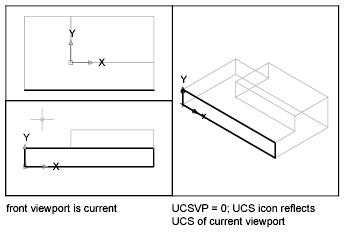To facilitate editing objects in different views, you can define a different user coordinate system (UCS) for each view.
Each time you make a viewport current, you can use the same UCS orientation that you used the last time that viewport was current.
The UCS in each viewport is controlled by the UCSVP system variable, which can also be accessed with the UCSMAN command, on the Settings tab. When UCSVP is set to 1 in a viewport, the UCS last used in that viewport is saved with the viewport and is restored when the viewport is made current again. When UCSVP is set to 0 in a viewport, its UCS is always the same as the UCS in the current viewport.
For example, you might set up three viewports: a top view, front view, and isometric view. If you set the UCSVP system variable to 0 in the isometric viewport, you can use the Top UCS in both the top viewport and the isometric viewport. When you make the top viewport current, the isometric viewport's UCS reflects the UCS top viewport. Likewise, making the front viewport current switches the isometric viewport's UCS to match that of the front viewport.
The example is illustrated in the following illustrations. The one shows the isometric viewport reflecting the UCS of the upper-left, or top, viewport, which is current.

The next illustration shows the change that occurs when the lower-left, or front, viewport is made current. The UCS in the isometric viewport is updated to reflect the UCS of the front viewport.
